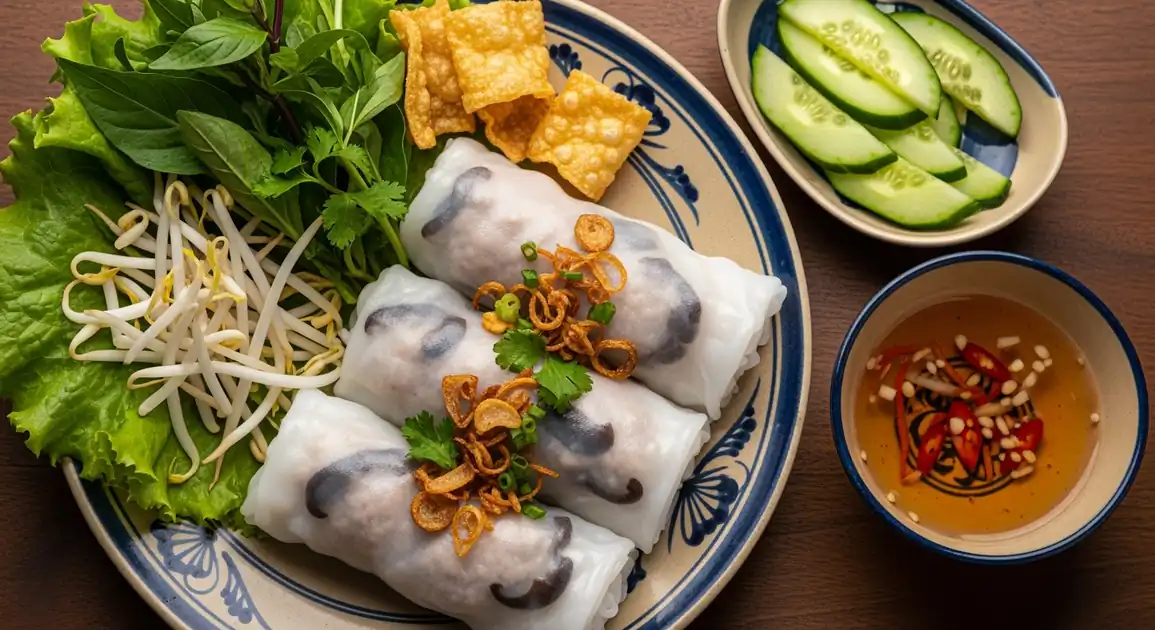Bánh Cuốn (Steamed Rice Rolls)
Bánh Cuốn

Description
Bánh Cuốn is found throughout Vietnam but is most authentic in the northern regions, particularly Hanoi and its surrounding areas. While regional variations exist, the northern style with its paper-thin texture and delicate flavors is considered the gold standard. In central and southern Vietnam, you'll find variations that are often thicker with different accompaniments.
Dietary Information
Serving information
Serving style
Served on a plate or in a shallow bowl, with the rolls pre-cut into bite-sized pieces. Accompanied by a separate small bowl of nước chấm dipping sauce. Herbs, bean sprouts, and chả lụa (Vietnamese pork sausage) are typically arranged alongside or on top of the rolls. Eaten with chopsticks.
Quick facts
Most traditional vendors operate from 6 AM - 11 AM, while restaurants and food courts may serve it throughout the day until 8 PM.
Safety Tips
What to Look For
-
Rice sheets steamed fresh to order
Quality vendors make the rice sheets on the spot. The steaming process (100°C/212°F) effectively kills potential pathogens in the batter.
-
Pre-cooked filling that's kept hot
The pork filling should be fully cooked beforehand and kept at safe temperatures. It should look fresh and be added to rice sheets while still warm.
-
Clean steaming station and utensils
The cloth used for steaming should appear clean, and utensils should be washed between batches or kept in clean water.
-
Fresh, vibrant herbs and garnishes
Herbs and vegetables should look freshly cut, bright green, and crisp - not wilted or discolored.
What to avoid
-
Pre-made rolls sitting at room temperature
Bánh Cuốn should ideally be made to order. Pre-made rolls sitting out, especially in warm weather, can harbor bacteria.
-
Cloudy or strange-smelling dipping sauce
The nước chấm should be clear amber, not cloudy or off-smelling. Good vendors make fresh sauce daily.
-
Dirty preparation area or utensils
Avoid vendors with visibly unclean conditions, especially those handling money then food without washing hands.
-
Wilted or browning herbs and vegetables
These indicate old ingredients that may have been sitting out too long and can harbor bacteria.
Price information
Price range
Budget tips
- Street vendors typically charge 25,000-35,000 VND for a standard portion.
- Specialty restaurants may charge 40,000-70,000 VND for premium versions with better quality ingredients.
- Adding extra chả lụa (pork sausage) usually costs 10,000-15,000 VND.
- Early morning (before 8 AM) vendors often offer the best value and most authentic versions.
Value indicators
- Thin, almost transparent rice sheets (indicating skill).
- Generous filling-to-wrapper ratio.
- Freshly made to order, not pre-rolled.
- Ample fresh herbs and garnishes included.
- House-made chả lụa instead of commercial.
Where to Find This Dish
Old Quarter Streets
Many small alleys and side streets in Vietnam's city centers have long-running family Bánh Cuốn businesses.
Local markets, Food streets, Morning market areas
Early Morning, Late Morning
Market Areas
Local fresh markets usually have dedicated food sections with several Bánh Cuốn vendors.
Wet markets, Morning markets, Food courts
Early Morning, Mid-Morning
Vendor Tips
- Family-run stalls advertising 'Gia Truyền' (family traditional) often maintain the best techniques passed through generations.
- Some vendors specialize exclusively in Bánh Cuốn while others offer it alongside other dishes - specialists typically produce better quality.
- Vendors with visible steaming stations where you can watch the preparation process typically offer fresher product.
How to Order
Regional Variations
-
Bánh Cuốn Nhân Thịt
(Bánh Cuốn Nhân Thịt)
The classic version with ground pork and wood ear mushroom filling, served with herbs, bean sprouts, and fried shallots.
-
Bánh Cuốn Thanh Trì
(Bánh Cuốn Thanh Trì)
An unfilled version from Thanh Trì village (now part of Hanoi), served plain with extra fried shallots and sometimes small pieces of chả lụa (Vietnamese pork sausage).
-
Bánh Cuốn Tôm Thịt
(Bánh Cuốn Tôm Thịt)
Luxury version with both ground pork and shrimp filling, offering a more complex flavor profile and richer taste.
-
Bánh Cuốn Chay
(Bánh Cuốn Chay)
Vegetarian version with mushroom and tofu filling, served with vegetarian dipping sauce (no fish sauce).
-
Bánh Cuốn Nóng
(Bánh Cuốn Nóng)
Emphasizes serving the rolls hot and fresh directly from the steamer for optimal texture.
-
Bánh Cuốn with Chả Lụa
(Bánh Cuốn với Chả Lụa)
Standard Bánh Cuốn served with larger portions of Vietnamese pork sausage (chả lụa) on the side.
Cultural context
History
Originating in Northern Vietnam, particularly in Hanoi and its surrounding villages, Bánh Cuốn reflects the region's emphasis on subtle flavors and refined techniques. Historically, specific villages specialized in making this dish, with Thanh Trì (now part of Hanoi) being especially renowned. The dish evolved from humble beginnings as a breakfast staple for farmers to becoming a beloved national dish, with each region developing slight variations while maintaining the core technique of steaming delicate rice sheets.
Local significance
Bánh Cuốn represents the subtlety and refinement of northern Vietnamese cuisine, emphasizing technique and delicate flavors over strong spices. It showcases the Vietnamese talent for creating exquisite textures from simple ingredients.
Eating customs
- Vietnamese typically dip each piece lightly in nước chấm before eating.
- Adding fresh chili to the dipping sauce according to personal preference is common.
- Each bite often combines the roll with herbs and a small piece of chả lụa (pork sausage).